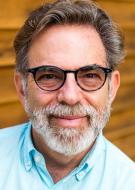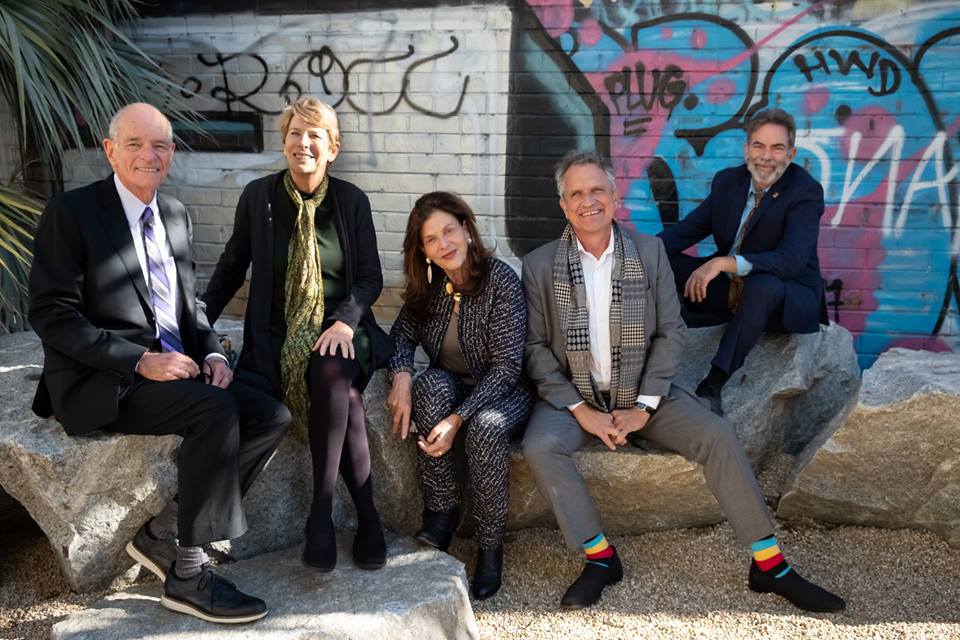
In early December, KCRW's Warren Olney, LA County Supervisor Mark Ridley-Thomas, LA City Councilmember Marqueece Harris-Dawson, and TreePeople President Andy Lipkis, among others, gathered at Studio-MLA to honor Mia Lehrer and architect Michael Lehrer with the American Jewish Committee’s Ira Yellin Leadership Award. Both have have worked for decades to green Los Angeles through designing schools, infrastructure, parks, the LA River. VX News is pleased to present Andy Lipkis’s remarks linking the Lehrers' architectural and civic contributions to the adaptation and investment challenges Los Angeles must address given our "new abnormal" climate.
I want to talk seriously about who we are and the conditions we face today. I’m often in the position of delivering inconvenient truths. Earlier this year, TreePeople held community meetings in Los Angeles to warn people about the fires that were coming. These fires were not a surprise; they have happened every 30 years in an exact pattern. We knew, when the winds were predicted to be at 50 miles an hour, that if there were a spark, it would go to the ocean—and it did. But people don’t want to hear it. They have faith that someone else is going to take care of it.
The head of the National Resources Agency for the state of California, John Laird, oversees CalFire and most emergency services in the state. He held a meeting last September where he told about 120 state leaders, “The reason we’re here is that the infrastructure that we’ve built in this state to protect public health, safety, and the economy from severe and extreme weather and climate—that infrastructure was built for a different climate than we have today. We can no longer guarantee the protection of the health and safety of our people or the economy. That’s what we’re here to address today.”
Within a week, we saw the hurricane in Houston. The next week, Florida. The next week, Louisiana. The following week, the fires in Santa Rosa. Two weeks later, the fires down here. In each case, there is evidence that the infrastructure and emergency services were completely overwhelmed and unable to be there for people. What saved them—if they were saved—was neighbors holding hands with neighbors. The people who were most safe were in communities where people talked to each other ahead of time.
At two in the morning, when the fire is coming, and you haven’t met your neighbor, and you don’t know whether they’re awake or not, and you’re going to have to throw a brick through their window to wake them up and get them out, and you haven’t talked so you don’t know if you might get shot, those 30 seconds you’re considering whether you’re going to run or bring them with you can mean your life or their life. That is exactly how it plays out.
I was raised by this community—I went to the Jewish summer camp JCA Shalom—and I learned about Tikkun Olam and social connectivity. Seeing things the way that I learned to through nature studies also helped me to see that things were flowing in the wrong direction here for our safety and our survival. There was so much enforced climate denial that had people thinking, “It can’t be that bad. We don’t have to do anything.”
When the Rodney King incident happened, TreePeople was well on our way to greening Los Angeles. I saw the aftermath as our failure. People said to me, “How can you possibly hold yourself accountable for that?” I said, “TreePeople’s work is to make life better. We don’t plant trees to decorate Los Angeles. We plant trees to heal—whether it’s economic situations, food security, or heat.”
The sociologists studying what caused the LA Riots concluded that we needed 50,000 new jobs for chronically unemployed and underemployed urban youth in Los Angeles. Even when our economy flourished, they had no hope of participating in it. So why not turn to violence and get what you need?
I’m a cofounder of the Los Angeles Conservation Corps with Mickey Kantor. We were giving kids hope through a year working in conservation. They were tasting their power. But then they were sent back to the warehouse of human energy in the inner city without a chance of a job. Seeing our kids from the Corps die in urban violence broke me.
There’s a reason I’m telling you this story; it goes right to where my work with Michael Lehrer started 26 years ago. We saw that call for 50,000 jobs. We brought some of the first money to Los Angeles from the White House, in tiny drops: $13 million from the Forest Service to employ 400 people for four months. They’d be bussed to the Angeles Forest, where they’d plant trees and clean trails, and then be bussed back every day. That, to me, was not a success. It was a model of unsustainability. But I was looking for how to create those 50,000 jobs, and we found it in the mismanagement of our ecosystem.
What would it cost to employ 50,000 young people in Los Angeles? A half-billion dollars a year. That kind of money never came out of the federal government in response to the riots. Except that some months later, the US Army Corps of Engineers showed up in Los Angeles with a half-billion dollar project—enough to employ 50,000 kids.
What was the job? To raise the walls of the LA River by two to 10 feet from here to Long Beach to get rid of the water that we were throwing away. We had so sealed the land that the next 50-year flood we had would wipe out the southern half of the county.
My work with Michael and Mia has been about swimming upstream. It was seeing that we were building wrong, we were doing community wrong, we were doing everything wrong—and no one could see it, because they only saw a beautiful, successful city. But imagine if we could capture that water and make it part of our water supply. It would provide enough income to employ 50,000 people in caring for the land—planting trees, capturing water, removing concrete, and doing the healing and Tikkun Olam that, to some degree, the Jewish community celebrates every year on Tu BiShvat, when we honor trees.
We began a multipronged partnership. We were all tied together with green infrastructure. Mia is a landscape architect, which most people think of as decorating the world; Michael builds buildings, which many people also see as decorating the world. But their work has nothing to do with that. It truly has healing as its core.
I met Mia when we pulled together a design event that brought 100 of the best minds in landscape architecture and architecture and engineering from around North America to design a way to retrofit Los Angeles entirely to function as a watershed ecosystem—to capture all that water and generate 50,000 jobs, safety from floods, and sufficient water to get us through the droughts and to protect us from severe heat. Mia was one of those designers who created an incredible plan that we’ve had to prove over and over again is the way to go forward. The city has now accepted it; the county has accepted it.
I met Michael when, as head of AIA, he was helping lead the task force to retrofit Los Angeles schools using the largest school bond in US history. I looked at LAUSD’s budget—$2.5 billion when it started—and found that they were going to spend almost $200 million putting more asphalt in LA school campuses, when what we needed to do was take it out in order to protect the kids from skin cancer and cool it down. Michael and I began a partnership—again, swimming upstream—to turn it around.
The Lehrers’ lives have impact. Their work—whether it’s greening schools, which touches millions of kids; building synagogues, churches, or summer camps; working in green infrastructure; or redesigning the LA river, schools, parks—it’s all about health. Together, their work has touched the lives of millions of Angelenos and people beyond the city. The impact is human.
The work confronting us is scary. Solving the problems before us will take all of us holding hands and connecting our values. The urgency is today. But what the Lehrers’ work represents is hope, power, and the ability to make change radically and beautifully. It’s the ability to change institutions, and to work with business and the community to make things happen…
This ceremony today, hosted by the American Jewish Committee, is a celebration of the values that this family represents. This family of Los Angeles—this family of Jews integrated with this community—is being called upon to stand up and access the values that are inherent in us and that have saved us in the past.
We have here today heroes who are bringing us together, causing us to hold hands, and giving us a way to have hope and strength and partnership. That’s why we’re presenting them with the Yellin Leadership Award. The design of this sculpture represents something sprouting—seeds of hope, seeds of dreams, or seeds of strength—all united in the soil of rainbow colors representing who we are. Mia and Michael, it’s a delight to present this award to you on behalf of the American Jewish Committee.

